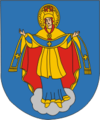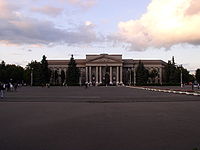- Maladzyechna
-
Maladzyechna
Belarusian:Маладзе́чна
SealCoordinates: 54°19′15″N 26°51′26″E / 54.32083°N 26.85722°E Country  Belarus
BelarusVoblast Minsk Voblast Raion Maladzyechna Raion Population (2006) – Total 98,514 Time zone EET (UTC+2) – Summer (DST) EEST (UTC+3) Maladzyechna (Belarusian: Маладзе́чна, pronounced [maɫaˈdzʲetʂna]; Russian: Молоде́чно, Polish: Mołodeczno, Lithuanian: Maladečina), is a city in the Minsk Voblast of Belarus, an administrative centre of the Maladzyechna district (and formerly of the Maladzyechna Voblast). It has 98,514 inhabitants (2006 estimate)[1] and is located 72 km northwest of Minsk. Located on the Usha River, it has been a settlement since 1388 when it was part of the Grand Duchy of Lithuania. It was also home to the Cold War facility Maladzyechna air base.
Contents
History
The fortification on the right bank of the Usha was first mentioned in 1388, although it is probable it was erected even before that date. Rectangular earthworks with stone walls 3,5 metres high and 11 metres wide formed the basis of the future castles and military camps formed on that location.[2] The town itself was first mentioned the following year in a document issued by Kaributas, Prince of Severian Novgorod, who on December 16 assured his tributary fidelity to his cousin, King Jogaila and Jadwiga of Poland.
In 1501 the place was donated by King Sigismund I the Old to certain Michael of Mstislav, on the condition that the latter provided a safe river passage for the nobles and hunters dwelling in the area. The privilege was further confirmed on July 12, 1511[3]
After Michael's heirless death, the locality passed through different hands until finally in 1567 it was acquired by Prince Nastasi Zbaraski, the voivod of Trakai. In 1568, that is the following year, a battle took place in the vicinity of the castle, in which the 40,000 men strong army of the Polish-Lithuanian Commonwealth defeated the forces of Muscovy. In 1617 it was bought by Lew Sapieha, the Grand Chancellor of Lithuania. Around that time the village had 1000 inhabitants. On August 20, 1631 Sapieha sold it to Stanisław Siemiott, the chamberlain of Samogitia, who then divided the villages surrounding Maladzyechna among his sons. Following a testament conflict between the descendantd of Siemiott and Aleksander Gosiewski, the Voivod of Smolensk, the town remained a property of the Gosiewski family. During their ownership of Maladzyechna the fortifications were extended and strengthened significantly by addition of several bastions. Around that time Maladzyechna started to be referred to as a town, even though it was officially a village and was not granted with a city charter. Nevertheless, it served as a centre of trade and commerce for the surrounding villages and also gained significant profits from transit between Lithuania and Poland. In 1708 the castle was one of the headquarters of the Swedish Army of King Charles XII of Sweden, which led to its partial devastation in the effect of a battle between the Swedes and the Russian forces.
On September 18, 1711 Bishop Bogusław Gosiewski, sold the town to the mighty Ogiński family. Among the owners of the area were Kazimierz Ogiński and Tadeusz Ogiński, the Castellan of Trakai (Lithuania). The Ogiński family became the main benefactors of the area, as they made it one of the main centres of their domain. They erected a new, classicist palace with notable frescoes, as well as a late renaissance church. It was also them to ask the king Sigismund II Augustus to grant the town with a city charter. Although it was not granted, in 1730 the monarch granted the town with the privilege of organization of two fairs a year and 2 markets every week. In mid-18th century the Ogiński's also founded a monastery of the Trinitaries there.
Following the Partitions of Poland, the area was annexed by Imperial Russia and the palace was abandoned soon afterwards. The castle was also neglected. During the final stages of Napoleon's invasion of Russia it was there that the Grande Armée made its last stand in former Grand Duchy of Lithuania. In early November 1812 Napoleon Bonaparte gave his last orders to his marshals there, after which he left for Vilnius. On November 21 of that year the Polish-born Russian general Yefim Chaplits arrived at the French camp there and defeated the already-routed French forces led by Marshal Victor. In the effect of the fights the town was completely demolished, as were the monastery and the castle. Because of that, in mid-19th century the town had not more than 500 inhabitants.
It was not until the later part of the century that the town started to gradually recover. In 1864 a Russian-language school was opened there and in 1871 an Orthodox church of Intercession of Our Most Holy Lady was built at the main town square. In 1873 it was linked to the world by the Minsk–Vilna railway, which sparked a period of economic recovery of the entire region. In early 20th century an additional rail line was opened, linking Saint Petersburg and Polotsk with Lida and Siedlce. This made the town a major railway junction and attracted many new settlers, in large part Jewish. By the outbreak of World War I the town had already over 2,000 inhabitants.
During the war, the town was the headquarters of the Russian 10th Army of the Western Front. Between February and December 1918 it was under German occupation, but was then seized by the Bolshevik forces during the Russian Civil War. On July 4, 1919 the town was captured by the Polish Army units led by Gen. Stanisław Szeptycki,[2] during their advance towards Minsk. However, the town was again briefly held by the Russian forces in the course of the Polish-Bolshevik War. Following the Riga Peace Treaty it was transferred to Poland, but the border between Poland and the Soviet Union was only 30 kilometres to the east, which cut Mołodeczno, as the town was known in Polish, from much of its economical background. To counter the threat of economic decline, on April 26, 1929 the town was granted with city rights and became a capital of a separate powiat within the Wilno Voivodship.
In the effect of the Polish Defensive War and the Molotov-Ribbentrop Pact, the town was occupied by the Red Army and annexed to the Byelorussian SSR, where it became part of the Vileyka Voblast on December 4, 1939. The NKVD expropriated the local school for teachers and set up one of its concentration camps there. After the German invasion of USSR the camp was set free, but at the same time the new German authorities sent most of the local Jewish inhabitants to the German concentration camps throughout the occupied Europe. In addition, the German Wehrmacht has set up the infamous Stalag 342 for the Soviet prisoners of war there, in which at least 30,000 people were killed.[2] On July 5, 1944 the advancing Red Army occupied once more the town, and annexed again to the USSR. The heavy damage that Vileyka suffered during the war, made it unsuitable to perform the role of the administrative centre, thus the Maladzyechna, which was located only 20 kilometres away from Vileyka, became the new administrative centre when the civilian control was restored in the BSSR on 20 September 1944. The Maladzyecna Voblast also survived the 1954 reform which halved the amount of Voblasts in the BSSR, but on 20 January 1960, the Voblast was disestablished, and the town of Maladzyechna became part of the modern Minsk Voblast, in which it remains today as part of the Republic of Belarus.
Sights
Near Maładečna there is a VLF-transmitter for transmitting time signals.
Notes and references
- ^ (English) Stefan Helders (2005). "Maladzečna". World Gazetteer. http://www.world-gazetteer.com/wg.php?x=&men=gpro&lng=en&dat=32&geo=-43&srt=npan&col=aohdq&pt=c&va=&geo=519572686. Retrieved 2006-06-02.
- ^ a b c (Polish) Piotr Bielerzewski (2004). "Mołodeczno". Rzeczpospolita Wirtualna. http://rzecz-pospolita.com/molodeczno.php3. Retrieved 2006-05-16.
- ^ (English) (Polish) Filip Sulimierski, Bronisław Chlebowski, Władysław Walewski, ed (1885). Słownik geograficzny Królestwa Polskiego i innych krajów słowiańskich. VI. Warsaw: Wł. Walewski. p. 960. http://www.polishroots.org/slownik/molodeczno.htm. Retrieved 2006-05-16.
See also
External links
- Photos on Radzima.org
- Photos on Globus Belarusi
- (Russian) Official website
- (Russian) Molodechno history
- (Russian) Molodechno geography
- (Russian) Molodechno transport
- (Russian) Molodechno news
 Subdivisions of Minsk Region, Belarus
Subdivisions of Minsk Region, BelarusDistricts
(raioni)Barysaw · Berazino · Chervyen · Dzyarzhynsk · Kapyl · Kletsk · Krupki · Lahoysk · Lyuban · Maladzyechna · Minsk · Myadzel · Nesvizh · Pukhavichy · Salihorsk · Slutsk · Smalyavichy · Staryya Darohi · Stoŭbtsy · Uzda · Valozhyn · Vileyka
Cities 1 Seat of the Voblast but administratively separatedCoordinates: 54°19′15″N 26°51′26″E / 54.32083°N 26.85722°E
Categories:- Populated places in Belarus
- Minsk Voblast
Wikimedia Foundation. 2010.



